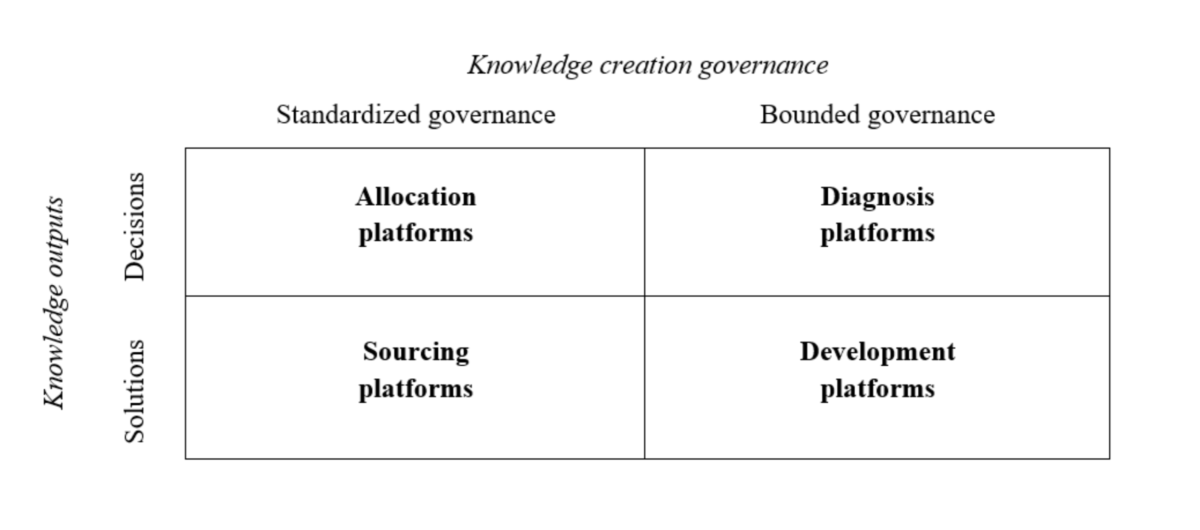Making sense of our connected world

The plurality of digital B2B platforms
In the era of digital transformation, platforms like Alibaba and MoBase have emerged as pivotal infrastructures for business-to-business transactions, quietly shaping the landscape of commerce behind the scenes. While these interactions may not be directly visible in everyday consumer life, they significantly impact the availability, cost, and quality of essential products and services. This blog post explores the diversity of digital B2B platforms through the lens of organisational studies. According to their governance styles (standardised vs. bounded) and strategic aims (decisions vs. solutions), four types of digital B2B platforms can be distinguished. How do they each shape the future of business interactions?
What are B2B markets? What is new about digital B2B platforms?
Digital B2B platforms are recognised as distinct phenomena (Anderson et al., 2022). Their uniqueness stems from their capacity to capitalise on digital technologies (Teece et al., 2022), expand market reach beyond geographical boundaries (Jean & Kim, 2021; Lanzolla & Frankort, 2016), and enhance efficiencies in industrial markets (Marzi et al., 2023).
One intriguing feature of digital B2B platforms that sets them apart from traditional firms operating in B2B markets is that they typically don’t own any physical assets, meaning that they don’t produce or sell goods and/or services themselves (Barrett et al., 2016; Malhotra et al., 2017). Instead, they offer digital infrastructures over which affiliated users, such as supply and demand side users, can transact and innovate goods and/or services. As such, they create and capture value with algorithms instead of humans (Faraj et al., 2018; Schildt, 2017; Snow et al., 2017; von Krogh, 2018). Let’s look at MoBase as a digital B2B platform for railroad infrastructure and rolling stock. MoBase does not manufacture any of the products they offer. Instead, they provide a platform for companies to sell their products to rail operators. Besides these fundamentals, important questions remain. In this essay, we tackle the following ones: (1) What are the key features of digital B2B platforms? (2) How are they governed and what is their main purpose? And (3) what are types of digital B2B platforms?
The Rise of the Platforms in B2B Markets
The platform economy rose to prominence on the backs of consumer-to-consumer (or peer-to-peer, P2P) platforms such as Uber and Airbnb and business-to-consumer (B2C platforms such as Amazon, Mechanical Turk, and Clickworker (Laamanen et al., 2018; Lehdonvirta et al., 2018). In the wake of increasing digitisation and trends like Smart Manufacturing or Industry 4.0 (European Commission, 2018; Liu, 2018; Vătămănescu & Alexandru, 2018) digital business-to-business (B2B) platforms are on the rise. The digital B2B platform economy is expected to provide promising business opportunities. As a result, numerous platforms with different governance structures and for varied purposes are emerging. However, given the newness of the phenomenon, we don’t fully understand their key features and different digital B2B platform archetypes. This article represents one step to address this issue.
Key Features of Digital B2B Platforms
Compared to traditional industrial enterprises, digital B2B platforms are fundamentally different in their assets, capabilities, and algorithm-based fundament. (1) Digital B2B platforms do neither produce nor sell any of the assets (e.g., products and/or services) transacted or innovated on their platforms. Value is instead created collectively by platform users (so called complementors) who contribute to the platform’s legitimacy and reach. The platform itself serves as an intermediary between different user groups (Baralou & Tsoukas, 2015; Barrett et al., 2016; Malhotra et al., 2017). Thus, the main asset of a platform is a solid and efficient organisation of their digital infrastructure to facilitate transaction and innovation. (2) To capitalise on these assets, digital B2B platforms require distinct sets of capabilities. Helfat and Raubitschek (2018) concluded that they utilise three capabilities: innovation capabilities, environmental scanning capabilities, and integrative capabilities.
Innovation capabilities focus on seizing and reconfiguring activities. They use the generativity of digitalisation to support technological development. Environmental scanning capabilities allow to sense opportunities and threats. Salesforce, for example, started as a customer relationship management (CRM) software company. It offered cloud-based solutions for managing and analysing customer interactions and data. But soon they sensed the value of becoming a broader cloud-based business platform. This move allowed Salesforce to cater to a wider range of B2B needs in the enterprise software market. Integrative capabilities deal with the introduction and modification of resources, capabilities, and business models. Users who deliberately provide social capital and knowledge are crucial for the success of an digital B2B platform (Lehdonvirta et al., 2018). (3) A digital infrastructure that enables intermediation is key. More specifically, these infrastructures hinge upon algorithms. Digital B2B platforms thus constantly innovate and refine their algorithms (Faraj et al., 2018; Schildt, 2017; Snow et al., 2017).
Operating Modes of Digital B2B Platforms
Now we turn to the key operating modes of digital B2B platforms, governance and platform purpose. Governance determines who is allowed to participate on a platform and how (Altman et al., 2022). Platform governance can be seen as a continuum of varying standardisation (March & Simon, 1958; Thompson, 1967). Standardised governance is suited for repeatable tasks of higher uniformity, such as the transactions taking on a platform which can be automated with respect to price comparisons, processing payment, and invoice creation. In contrast, bounded governance grants additional degrees of freedom as only some regulatory procedures are established. Thus, rendering this operating mode particularly appropriate for more complex tasks.
In addition, digital B2B platforms show varying purposes which result in different outputs: decisions or solutions. Users can, for instance, authorise digital platforms to perform humanlike decisions. This is the case with high-frequency trading platforms. But platforms can also use algorithms to solve user problems. Consider crowdsourcing platforms that can draw on the wisdom of the crowd to provide innovative solutions (von Krogh, 2018).
Types of Digital B2B Platforms
Building on the respective poles of governance as well as purpose we derive four distinct types of digital B2B platforms: allocation platforms, sourcing platforms, diagnosis platforms, and development platforms (see Figure 1).

Allocation platforms feature a comprehensive standardised set of procedures to govern platform users. They blend this standardised governance with decision-making algorithms. Examples are high-frequency trading platforms or automated supply chain platforms such as e2open. E2open helps companies to integrate and automate their end-to-end supply chain processes. The platform provides businesses with the visibility, control, and flexibility needed to respond quickly to market changes and customer demands. Allocation platforms are best suited to allocate resources, may it be monetary resources or human resources. Sourcing platforms use standardised governance procedures to solve problems. MoBase, a platform to buy spare parts related to railways, represents an illustrative case. Diagnosis platforms like Philips’ eCareCoordinator are characterised by a bounded governance of knowledge creation combined with decision making algorithms. Philips’ eCareCoordinator is a telehealth platform designed to support remote patient monitoring and chronic disease management. It works by providing healthcare professionals with tools and insights to monitor and manage patients’ health conditions remotely. More controversial but equally telling are predictive policing platforms. Here algorithms are leveraged to calculate the probability of criminal activities. Finally, development platforms couple bounded governance with solution-providing algorithms. Jovoto is a platform dedicated to product development while Testlio assures quality in software development.
Conclusion
The advent and rapid diffusion (Kenney & Zysman, 2016; Laamanen et al., 2018; Lehdonvirta et al., 2018) of digital B2B platforms as new forms of organising caught scholarship on its heels. Our understanding of these platforms remains largely dispersed. By elaborating on the key features, modes of operation, and platform types, we attempt to provide the first metaphorical bricks and mortar to further establish research on digital B2B platforms.
Authors
Patrick Holzmann studies how companies can leverage digital technologies in their business models for sustainable value creation at WU Vienna University of Economics and Business.
Alexander Engelmann examines how firms adapt to environmental changes, focusing on evolving technologies and shifting sustainability demands, at WU Vienna University of Economics and Business.
Georg Reischauer studies digital strategy, digital organization, and digital sustainability at WU Vienna University of Economics and Business as well as at Johannes Kepler University Linz.
This blog post benefitted from the feedback of Ali Aslan Gümüsay. It is supported by funds of the Oesterreichische Nationalbank (Austrian Central Bank, Anniversary Fund, project number: 18747).
References
Altman, E. J., Nagle, F., & Tushman, M. L. (2022). The translucent hand of managed ecosystems: Engaging communities for value creation and capture. Academy of Management Annals, 16(1), 70-101.
Anderson, E. G., Lopez, J., & Parker, G. G. (2022). Leveraging value creation to drive the growth of B2B platforms. Production and Operations Management, 31(12), 4501-4514.
Barrett, M., Oborn, E., & Orlikowski, W. (2016). Creating value in online communities: The sociomaterial configuring of strategy, platform, and stakeholder engagement. Information Systems Research, 27(4), 704-723.
European Commission. (2018). Industrial platforms and large scale pilots https://ec.europa.eu/digital-single-market/en/industrial-platforms-and-large-scale-pilots, Accessed Sept 24th 2018
Faraj, S., Pachidi, S., & Sayegh, K. (2018). Working and organizing in the age of the learning algorithm. Information and Organization, 28(1), 62-70.
Helfat, C. E., & Raubitschek, R. S. (2018). Dynamic and integrative capabilities for profiting from innovation in digital platform-based ecosystems. Research Policy, 47(8), 1391-1399.
Jean, R.-J. B., & Kim, D. (2021). Signalling strategies of exporters on internet Business-to-Business platforms. Journal of Management Studies, 58(7), 1869-1898. Kenney, M., & Zysman, J. (2016). The rise of the platform economy. Issues in Science and Technology, 32(3), 61-69.
Laamanen, T., Pfeffer, J., Rong, K., & Van de Ven, A. (2018). Business models, ecosystems, and society in the sharing economy. Academy of Management Discoveries, 4(3), 213-219.
Lanzolla, G., & Frankort, H. T. W. (2016). The online shadow of offline signals: Which sellers get contacted in online B2B marketplaces? Academy of Management Journal, 59(1), 207-231.
Lehdonvirta, V., Kässi, O., Hjorth, I., Barnard, H., & Graham, M. (2019). The global platform economy: A new offshoring institution enabling emerging-economy microproviders. Journal of Management, 0149206318786781.
Liu, J. (2018). Industrial mash-ups: A disruptive new partnering form will accelerate innovation – again. https://www.ey.com/Publication/vwLUAssets/ey-industrial-mash-ups/$FILE/ey-industrial-mash-ups.pdf, Accessed Oct 12th 2018
Lombardi, P., & Schwabe, F. (2017). Sharing economy as a new business model for energy storage systems. Applied Energy, 188, 485-496.
Malhotra, A., Majchrzak, A., & Niemiec, R. M. (2017). Using public crowds for open strategy formulation: Mitigating the risks of knowledge gaps. Long Range Planning, 50(3), 397-410.
March, J. G., & Simon, H. A. (1958). Organizations. Wiley.
Marzi, G., Marrucci, A., Vianelli, D., & Ciappei, C. (2023). B2B digital platform adoption by SMEs and large firms: Pathways and pitfalls. Industrial Marketing Management, 114, 80-93.
Schildt, H. (2017). Big data and organizational design: The brave new world of algorithmic management and computer augmented transparency. Innovation: Organization & Management, 19(1), 23-30.
Snow, C. C., Fjeldstad, Ø. D., & Langer, A. M. (2017). Designing the digital organization. Journal of Organization Design, 6(1), 7.
Teece, D. J., Pundziene, A., Heaton, S., & Vadi, M. (2022). Managing multi-sided platforms: platform origins and go-to-market strategy. California Management Review, 64(4), 5-19.
Thompson, J. D. (1967). Organizations in action: Social science bases of administrative theory. McGraw-Hill.
Vătămănescu, E.-M., & Alexandru, V.-A. (2018). Beyond innovation: The crazy new world of industrial mash-ups. In E.-M. Vătămănescu & F. M. Pînzaru (Eds.), Knowledge management in the sharing economy: Cross-sectoral insights into the future of competitive advantage (pp. 271-285). Springer International Publishing.
von Krogh, G. (2018). Artificial intelligence in organizations: New opportunities for phenomenon-based theorizing. Academy of Management Discoveries, 4(4), 404-409.
This post represents the view of the author and does not necessarily represent the view of the institute itself. For more information about the topics of these articles and associated research projects, please contact info@hiig.de.

You will receive our latest blog articles once a month in a newsletter.
Digital future of the workplace
AI at the microphone: The voice of the future?
From synthesising voices and generating entire episodes, AI is transforming digital audio. Explore the opportunities and challenges of AI at the microphone.
Do Community Notes have a party preference?
This article explores whether Community Notes effectively combat disinformation or mirror political biases, analysing distribution and rating patterns.
How People Analytics can affect the perception of fairness in the workplace
People Analytics in the workplace can improve decisions but may also heighten feelings of unfairness, impacting employee trust and workplace relationships.




